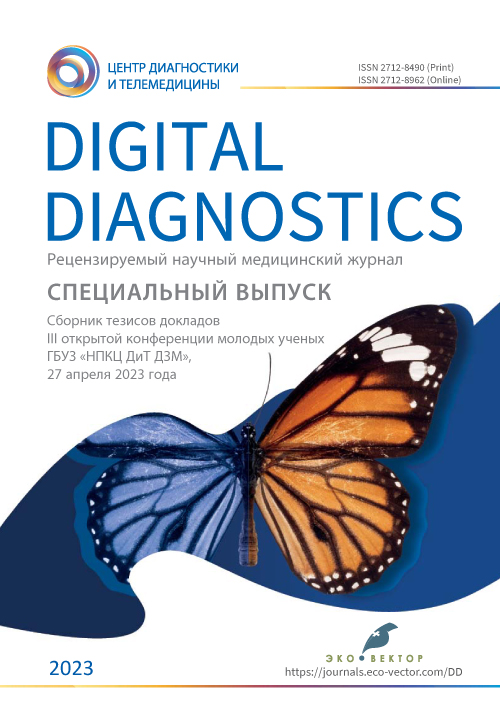Контроль количественной оценки фракции жира в магнитно-резонансной томографии: двухцентровое фантомное исследование
- Авторы: Панина О.Ю.1, Игнатьева В.А.2, Монахова А.А.2
-
Учреждения:
- Научно-практический клинический центр диагностики и телемедицинских технологий
- Московский государственный медико-стоматологический университет имени А.И. Евдокимова
- Выпуск: Том 4, № 1S (2023)
- Страницы: 96-98
- Раздел: Материалы конференции
- Статья получена: 18.05.2023
- Статья одобрена: 18.05.2023
- Статья опубликована: 26.06.2023
- URL: https://jdigitaldiagnostics.com/DD/article/view/430357
- DOI: https://doi.org/10.17816/DD430357
- ID: 430357
Цитировать
Полный текст
Аннотация
Обоснование: оценка количественных параметров с помощью магнитно-резонансной томографии (МРТ) является актуальным направлением. Расчёт фракции жира (FF) открывает новые возможности в точной постановке диагноза и в будущем позволит заменить инвазивные методы, такие как биопсия. Количественная оценка сможет позволить проводить достоверный динамический контроль, оценку лекарственной терапии и т.д. Однако рентгенологи, а также врачи клинических специальностей должны быть уверены в точности и достоверности количественных показателей.
Цель: оценка точности количественного измерения FF с помощью фантомного моделирования в диапазоне от 0 до 60%.
Методы: для моделирования объектов исследования были выбраны эмульсии по типу «масло в воде». Концентрации эмульсий на основе растительных масел были представлены в диапазоне 0–60%. Пробирки с эмульсиями помещались в цилиндрический фантом. Сканирование выполнялось на томографе Optima, MR450w 1,5 Tл (GE) в режиме «Lava Flex», а также на томографе Ingenia, 1,5 Тл (Philips) в режиме «DIXON». Фракция жира определялась расчётным методом по формулам, на основе сигнальных характеристик, по изображениям в фазе (In) и противофазе (Out): FF=(In–Out)/2∙In∙100; по изображениям, взвешенным по воде (Water) и по жиру (Fat): FF=Fat/(Fat+water)∙100.
Результаты: точность измерения процентного содержания жира при «DIXON» была идентична «Lava Flex». Данные измеряемых значений концентрации жира были систематически завышены по отношению к заданным в среднем на 57,6% при средней абсолютной разнице 17,2%. Также определялось неравномерное занижение в диапазоне 20–40%.
Заключение: фантомное моделирование с использованием прямых эмульсий по типу «масло в воде» позволило провести контроль работы диксоновских последовательностей в количественном определении жировой фракции. Для корректного количественного определения FF предпочтительнее проводить расчёты по данным изображений Water и Fat с использованием формулы FF=Fat/(Fat+water)∙100. Расчёты по изображениям In-phase и Out-phase предоставляют неоднозначные результаты. Для того чтобы корректно производить количественный расчёт фракции жира с помощью представленных выше формул в режимах «Lava Flex» и «DIXON» необходимо проводить расчёт с поправочным коэффициентом. Использование фантома дает возможность осуществлять надлежащий контроль качества и калибровку МР-томографа, а также делать количественное измерение жира широкодоступным.
Ключевые слова
Полный текст
Обоснование: оценка количественных параметров с помощью магнитно-резонансной томографии (МРТ) является актуальным направлением. Расчёт фракции жира (FF) открывает новые возможности в точной постановке диагноза и в будущем позволит заменить инвазивные методы, такие как биопсия. Количественная оценка сможет позволить проводить достоверный динамический контроль, оценку лекарственной терапии и т.д. Однако рентгенологи, а также врачи клинических специальностей должны быть уверены в точности и достоверности количественных показателей.
Цель: оценка точности количественного измерения FF с помощью фантомного моделирования в диапазоне от 0 до 60%.
Методы: для моделирования объектов исследования были выбраны эмульсии по типу «масло в воде». Концентрации эмульсий на основе растительных масел были представлены в диапазоне 0–60%. Пробирки с эмульсиями помещались в цилиндрический фантом. Сканирование выполнялось на томографе Optima, MR450w 1,5 Tл (GE) в режиме «Lava Flex», а также на томографе Ingenia, 1,5 Тл (Philips) в режиме «DIXON». Фракция жира определялась расчётным методом по формулам, на основе сигнальных характеристик, по изображениям в фазе (In) и противофазе (Out): FF=(In–Out)/2∙In∙100; по изображениям, взвешенным по воде (Water) и по жиру (Fat): FF=Fat/(Fat+water)∙100.
Результаты: точность измерения процентного содержания жира при «DIXON» была идентична «Lava Flex». Данные измеряемых значений концентрации жира были систематически завышены по отношению к заданным в среднем на 57,6% при средней абсолютной разнице 17,2%. Также определялось неравномерное занижение в диапазоне 20–40%.
Заключение: фантомное моделирование с использованием прямых эмульсий по типу «масло в воде» позволило провести контроль работы диксоновских последовательностей в количественном определении жировой фракции. Для корректного количественного определения FF предпочтительнее проводить расчёты по данным изображений Water и Fat с использованием формулы FF=Fat/(Fat+water)∙100. Расчёты по изображениям In-phase и Out-phase предоставляют неоднозначные результаты. Для того чтобы корректно производить количественный расчёт фракции жира с помощью представленных выше формул в режимах «Lava Flex» и «DIXON» необходимо проводить расчёт с поправочным коэффициентом. Использование фантома дает возможность осуществлять надлежащий контроль качества и калибровку МР-томографа, а также делать количественное измерение жира широкодоступным.
Об авторах
Ольга Юрьевна Панина
Научно-практический клинический центр диагностики и телемедицинских технологий
Email: olgayurpanina@gmail.com
ORCID iD: 0000-0002-8684-775X
Россия, Москва
Варвара Александровна Игнатьева
Московский государственный медико-стоматологический университет имени А.И. Евдокимова
Email: varvaraigna1612@gmail.com
ORCID iD: 0009-0009-6229-0342
Россия, Москва
Алёна Андреевна Монахова
Московский государственный медико-стоматологический университет имени А.И. Евдокимова
Автор, ответственный за переписку.
Email: malyona98@gmail.com
ORCID iD: 0009-0009-0271-2953
Россия, Москва
Список литературы
- Bray T.J., Chouhan M.D., Punwani S., et al. Fat fraction mapping using magnetic resonance imaging: insight into pathophysiology // Br J Radiol. 2018. Vol. 91, N 1089. P. 20170344. doi: 10.1259/bjr.20170344
- Panina O.Yu., Gromov A.I., Akhmad E.S, et al. Accuracy of fat fraction estimation using Dixon: experimental phantom study // Medical Visualization. 2022. Vol. 26, N 4. P. 147–158. doi: 10.24835/1607-0763-1160
- Corrias G., Erta M., Sini M., et al. Comparison of Multimaterial Decomposition Fat Fraction with DECT and Proton Density Fat Fraction with IDEAL IQ MRI for Quantification of Liver Steatosis in a Population Exposed to Chemotherapy // Dose Response. 2021. Vol. 19, N 2. P. 1559325820984938. doi: 10.1177/1559325820984938
- Reeder S.B., Hu H.H., Sirlin C.B. Proton density fat-fraction: a standardized MR-based biomarker of tissue fat concentration // J Magn Reson Imaging. 2012. Vol. 36, N 5. P. 1011–1014. doi: 10.1002/jmri.23741
Дополнительные файлы















